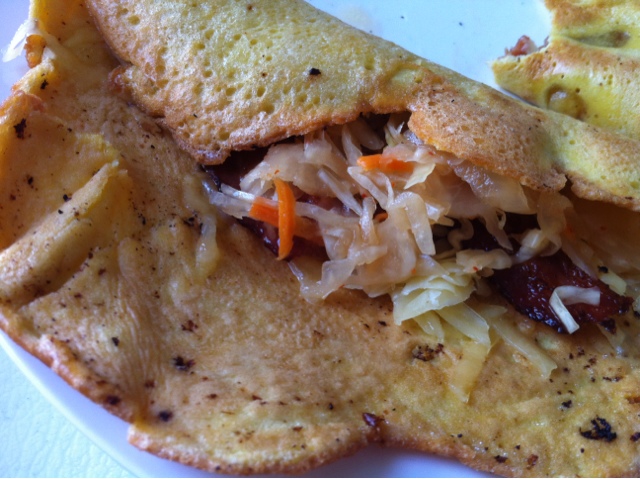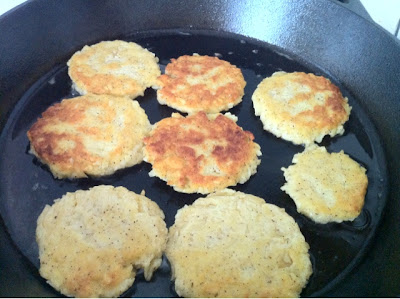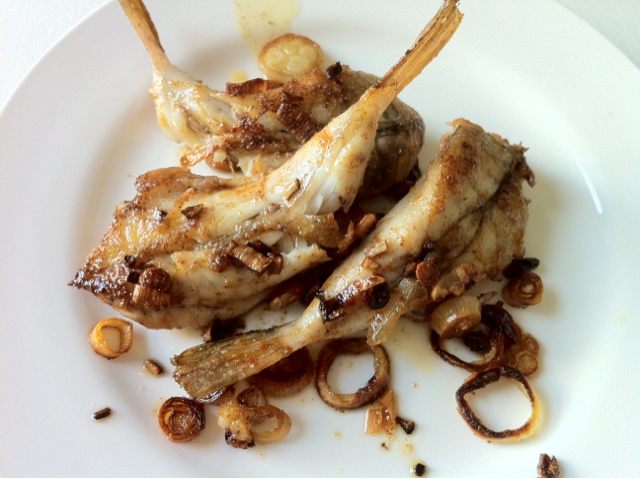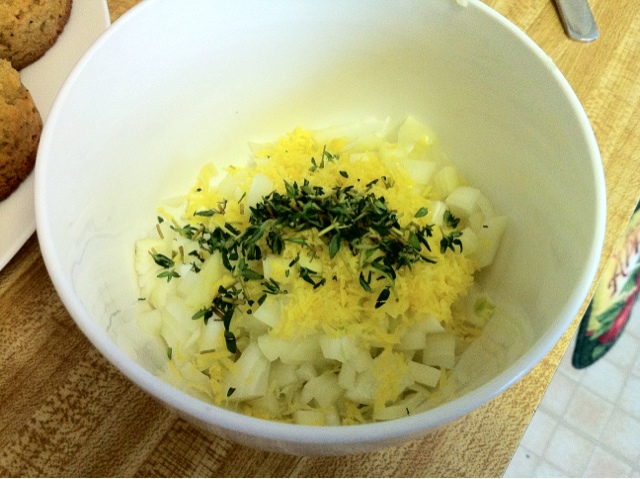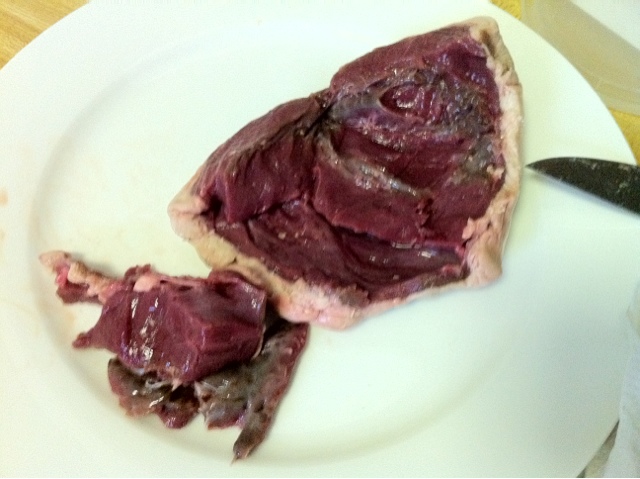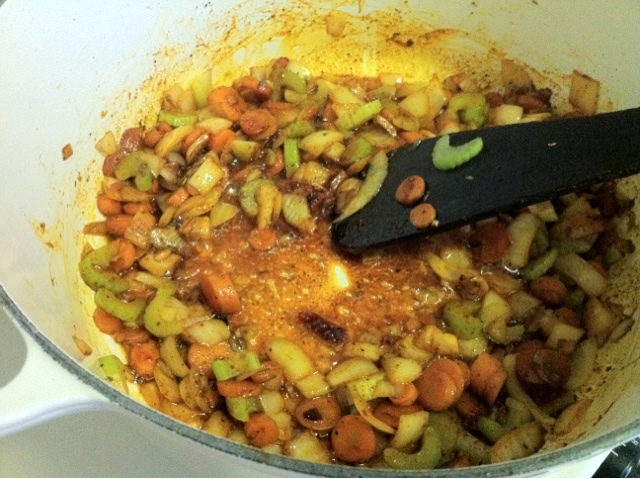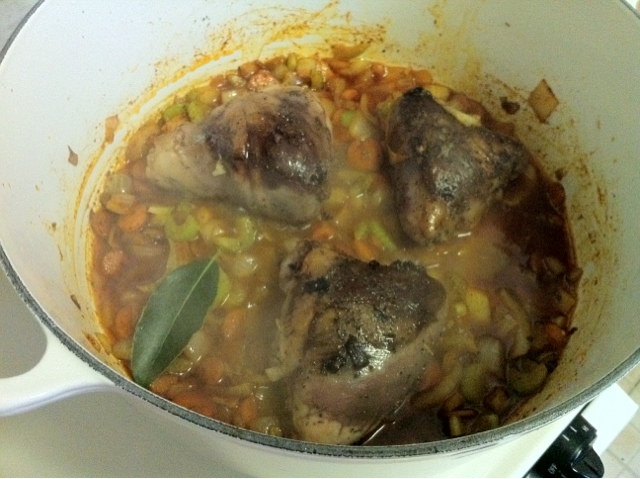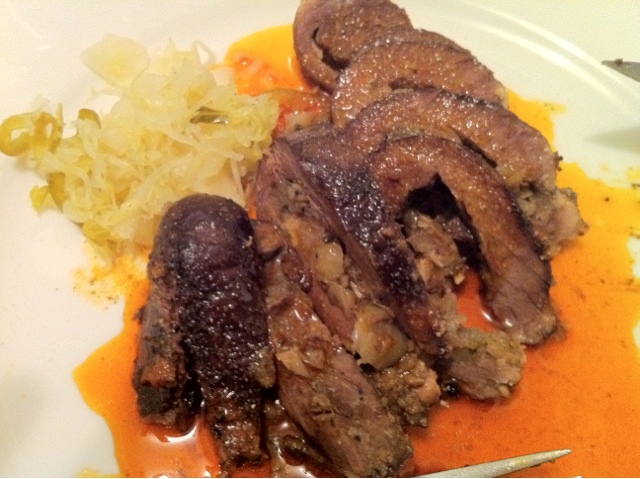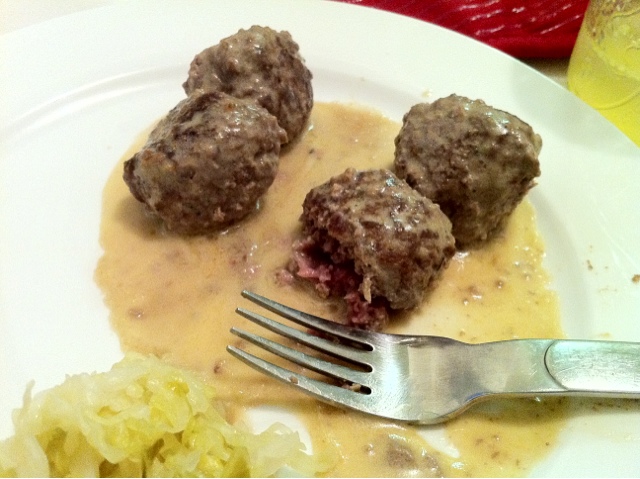Recently Hugo made our favorite family pancakes for Oliver's breakfast while I was at the farmers' market, and when I got back there was one left. I tasted it and asked, "where's the banana?" The recipe calls for 3 eggs, 2 tbsp nut butter, and 1 ripe banana....but the banana hadn't made it in there. The resulting thin crepe-like pancake was flexible and tasty -- and not too eggy! I added some homemade garlic-thyme yogurt cheese, a few strips of leftover bacon, and some fermented veggies, and wrapped it in aluminum foil for later. It made a surprisingly enjoyable snack!
I've made this a few times since, with a little extra cashew butter and salt. You can make about 4 thin crepes using 3 pastured eggs, 3 pinches of salt, and 3 Tbsp nut butter (I like homemade cashew butter made from soaked and dried organic cashews). Combine and blend in a food processor or blender. Pour the batter into a hot skillet coated in bacon fat or coconut oil to cook. Add grated cheese and a few strips of cooked bacon after you flip each crepe. Then top with shredded fermented veggies, roll up, and enjoy!
Hannah and Hugo meet in NYC. They build a cozy home and have their first baby (Oliver 8-12-08). After discovering the work of Weston Price they spend a year adopting a nutrient-dense traditional diet. In their Brooklyn kitchen raw cultured dairy, fermented veggies, bone broths & natural animal fats get top billing. The family welcomes Weston, who is born at home 12-3-11. The adventure continues...
Tuesday, November 20, 2012
Wednesday, November 14, 2012
Sunday, June 17, 2012
Potato pancake recipe
These delicious potato pancakes are a childhood favorite of mine, and a great way to use up any less-than-lovely potatoes you might have on hand (which is all I had to work with recently).
Be sure to get organic potatoes since chemical runoff concentrates in the soil. I used 6 small potatoes for this recipe, first washing and peeling them and cutting out the sprouts ("eyes") that had grown from them.
1. Steam your washed, peeled potatoes until tender when pierced with a sharp knife.
2. Allow to cool thoroughly. I like to cook potatoes ahead of time, while I'm preparing dinner on Saturday evening for example, and then put them in the fridge before I go to bed. That way they're ready for Sunday morning brunch.
3. Grate the potatoes on the biggest side of a box grater into a big bowl.
4. Combine with 1 egg (got a double yolk today! but it's only one egg), 1/4 tsp black pepper, and 1/2 + 1/8 tsp sea salt. Mix well.
5. Make small patties (I made 7 in all plus a tiny one) and fry in a very hot skillet with a generous amount of hot pastured chicken fat melted in the bottom.
6. Serve with butter and raw yogurt (my preference) or sour cream. These were a big hit today, served with omelets (seasoned with Herbes de Provence and goat cheese), and beef breakfast sausage from Grazin' Angus Acres, plus brown-rice-bread French toast for Hugo, and my homemade lactofermented vegetable medley.
Labels:
Breakfast,
Comfort food,
Potato recipes
Wednesday, May 30, 2012
Friday, May 25, 2012
Blowfish tails recipe: a springtime Greenmarket discovery
The seafood display at our Bay Ridge seasonal Greenmarket (Walgreens parking lot at 95th St and 3rd Ave) really caught my eye this past weekend. It was beautifully arranged and much more varied than usual. I noticed some appealing-looking little fish cuts in one corner and learned they were blowfish tails, and only available for a limited time. The guy behind the table gave me 3 to try and on the walk home I daydreamed about the spices I would use on them.
As soon as we got home I set to work sautéing several small bulbs of fresh spring garlic in plenty of grass-fed ghee. Then I added the tails and sprinkled on sea salt, ground ginger, cumin, and just a tiny dash of cayenne powder. According to the fish vendor's instructions I turned the tails once during cooking, and of course seasoned the other side as well. It as clear when they were done: the color of the fish had changed and there was a nice crust.
The results: unbelievably delicious! My mouth is watering as I type this and I can hardly wait to buy more tomorrow.
As soon as we got home I set to work sautéing several small bulbs of fresh spring garlic in plenty of grass-fed ghee. Then I added the tails and sprinkled on sea salt, ground ginger, cumin, and just a tiny dash of cayenne powder. According to the fish vendor's instructions I turned the tails once during cooking, and of course seasoned the other side as well. It as clear when they were done: the color of the fish had changed and there was a nice crust.
The results: unbelievably delicious! My mouth is watering as I type this and I can hardly wait to buy more tomorrow.
Tuesday, May 15, 2012
Awesomely easy steak tartare
Well, to be perfectly honest I should probably acknowledge that any steak tartare has got to be fairly easy and quick to make since it isn't even cooked! But it always seemed like one of those dishes that requires the sanction of a restaurant atmosphere.
Not so!
My friend Julia recently bequeathed me the contents of her freezer upon moving across the country, and since this enticing little package of ground steak tartare from Grazin' Angus Acres was already thawed I decided to enjoy it that very afternoon.
In a bowl, mix 8 oz. high-quality organic grass-fed ground steak with the following:
-1 pastured egg
-Organic Tamari to taste (this will add all the salt you need)
-Organic expeller-pressed sesame oil (start with a tsp or 2 and add more if desired)
-Fine-ground white pepper to taste (this stuff is spicier than the regular black variety so don't go too crazy!)
Mix well, tasting as needed, and turn out onto a serving plate, molding into a nice round shape. Garnish with snipped parsley or very thinly-sliced scallions (I didn't have any of the latter). Take small bites--I like to use chop sticks because it just makes it tastier--and enjoy the delicious smooth flavor. You will get an amazing boost of energy from this!
I offered some to Oliver and he gobbled it right up with me.
Not so!
My friend Julia recently bequeathed me the contents of her freezer upon moving across the country, and since this enticing little package of ground steak tartare from Grazin' Angus Acres was already thawed I decided to enjoy it that very afternoon.
In a bowl, mix 8 oz. high-quality organic grass-fed ground steak with the following:
-1 pastured egg
-Organic Tamari to taste (this will add all the salt you need)
-Organic expeller-pressed sesame oil (start with a tsp or 2 and add more if desired)
-Fine-ground white pepper to taste (this stuff is spicier than the regular black variety so don't go too crazy!)
Mix well, tasting as needed, and turn out onto a serving plate, molding into a nice round shape. Garnish with snipped parsley or very thinly-sliced scallions (I didn't have any of the latter). Take small bites--I like to use chop sticks because it just makes it tastier--and enjoy the delicious smooth flavor. You will get an amazing boost of energy from this!
I offered some to Oliver and he gobbled it right up with me.
Monday, May 7, 2012
A better use for a soda dispenser
I think I may have invented the first-ever mini-fridge chicken carcass dispenser! Since buying this fridge last month I've been vexed over the wasted space and have been trying to fit various things in there. It has now proved itself as the perfect spot for saving two lovely chicken carcasses until I'm ready to make broth. :)
Friday, April 13, 2012
Weston loves sauerkraut!
Weston turned 4 months on April 3rd and though that's still very young I just can't resist giving him some samples of healthy and digestible traditional foods.
So far he has tried tiny tastes of raw sour cream, raw kefir, homemade chicken liver pâté, beef broth, trotter (pig's foot) broth, chicken broth, and lactofermented pickles and sauerkraut. Sauerkraut and pickles are the clear winners! Of course he doesn't actually eat either, but he loves sucking on them and seems to relish the sour flavor.
Both are rich in lactobacilli (lactic-acid producing bacteria) which are essential for gut health--the basis for good digestion and absorption of nutrients, as well as immune function. These bacteria even aid in decreasing the permeability of the intestinal lining, which is important in preventing food sensitivities and intolerances due to "leaky gut." Babies have a naturally leaky gut which is why it's a good idea to emphasize bone broths and lactofermented foods (or liquids) when introducing solids.
So far he has tried tiny tastes of raw sour cream, raw kefir, homemade chicken liver pâté, beef broth, trotter (pig's foot) broth, chicken broth, and lactofermented pickles and sauerkraut. Sauerkraut and pickles are the clear winners! Of course he doesn't actually eat either, but he loves sucking on them and seems to relish the sour flavor.
Both are rich in lactobacilli (lactic-acid producing bacteria) which are essential for gut health--the basis for good digestion and absorption of nutrients, as well as immune function. These bacteria even aid in decreasing the permeability of the intestinal lining, which is important in preventing food sensitivities and intolerances due to "leaky gut." Babies have a naturally leaky gut which is why it's a good idea to emphasize bone broths and lactofermented foods (or liquids) when introducing solids.
Labels:
Baby feeding,
Baby food,
Lacto-fermented,
probiotics
Thursday, April 5, 2012
Put some heart in your mouth! (braised heart recipe)
I LOVE heart. For me it ranks right up there with my other favorites, like oxtail, goat neck, and tongue (and yes, I do plan to post my favorite recipes for these other variety cuts over the next few weeks). Try heart once, and it's likely you'll feel so good after eating it that you'll want to eat it again. After all, heart is a good source of protein, niacin, phosphorus, zinc, and copper, and a very good source of vitamin B12, riboflavin, iron, and selenium. Like liver, it is relatively low in fat but contains LOTS of brain-supporting, hormone-balancing cholesterol! And for all of you out there taking supplements for this or that, heart muscle supplies CoQ10 direct from the source.
So far I have used only one recipe, but three different kinds of heart meat: calf's heart, lamb hearts, and beef heart. (My chicken heart experiment, the one deviation from this, which involved sauteeing and lots of onions, was NOT a success.) I consider braising to be the best method for preparing heart since it is a very strong, muscular organ and responds well to long, slow cooking. (Unless you're visiting Takashi for some beef heart sashimi, which I will also post on soon!)
I found this great recipe from the NY Times website, and like to follow it as closely as possible. Here are the instructions, in pictures (I'm using pastured lamb's hearts here which is why I'm making three at once; when making a 2 lb. piece of beef heart I only end up with one heart "pillow" to braise):
1. the preliminary step: prepare your stuffing mix (1 small minced onion, 2 cloves minced garlic, 1 sprig fresh thyme, chopped, and zest of 1 organic lemon)
2. here is the lamb heart, surrounded by beautiful highly-saturated fat which will melt and flavor the stew
3. slice the heart open (skip this step if you are using pre-sliced heart rather than a whole one)
4. clean out the inside, removing as many of the sinews as possible without discarding precious meat, to leave a "clear hollow shell." It won't be pretty, but this doesn't matter!
5. salt and pepper the inside, add a large pat of butter, and fill with stuffing mixture
6. now the fun part: pretend you're a surgeon and stitch 'er up! (I used a regular needle and off-white thread.) I have been sewing since the age of 5 and love that this recipe incorporates both cooking AND sewing!
7. Repeat the above steps with the other hearts you are using (if any), then season the outside of the heart(s) with salt and pepper and brown in lots of hot fat (lard, tallow, or schmaltz) in a large Dutch oven or other heavy pan with a tight-fitting lid.
8. Remove the hearts from the pot and add the chopped veggies (1 onion, 2 carrots, 2 stalks celery, all finely chopped), stirring well. When the veggies have softened add 1 tbsp. sweet paprika (this is the regular paprika available in stores, differentiated from the smoked variety).
9. Return the hearts to the pot and add a bay leaf and 1 cup homemade beef stock (I have used chicken stock and beef tongue cooking liquid, both with good results; the only kind I wouldn't use would be fish).
10. Braise with the lid on until the hearts are tender when pierced with a sharp knife. This takes about 2 hours or so. Keep the heat around medium-low for a nice steady simmer, and turn the hearts every 20 minutes.
11. Now you're ready to eat! I recommend starting with a fresh green salad, then serving the sliced hearts with buttered potatoes or winter squash, plus lactofermented sauerkraut. Be sure to pour the rich fatty juice over the meat, and add unrefined sea salt to taste.
This is also GREAT left over.
Bon appétit!
Tuesday, March 20, 2012
How dirty is your water?
We found out the answer to this question this year. Although we've been using a Pur pitcher filter for a long time now, we hadn't gotten it together to buy a "real" water filter system. Now I'm mad I didn't prioritize this more! If I had seen this earlier I would have made the water filter happen sooner, in spite of our tight budget (as I would recommend you do!).
The one we settled on is the Doulton dual-chamber (fluoride and ultra carb filters) filter available from Radiant Life. We chose the under-counter option since we had no countertop space to spare.
Here's the filter after just two weeks of use (compare it to the filter housing which is in the sink and is the normal off-white color of the filter when it's clean):
Hugo now removes the filter and cleans it every weekend so the flow from the spigot stays fairly even most of the time. Since I make so much broth and ferment lots of veggies and beverages we really do go through a lot of filtered water.
We also got a shower head filter and a bath dechlorinator ball:
As they say on the Radiant Life website, either use a filter or BE the filter! After seeing our filters turn from off-white to charcoal black I am truly glad to no longer be the filter.
(Just a reminder that as with all my product, food, and supplement recommendations I receive absolutely no benefit from your following the above links.)
The one we settled on is the Doulton dual-chamber (fluoride and ultra carb filters) filter available from Radiant Life. We chose the under-counter option since we had no countertop space to spare.
Here's the filter after just two weeks of use (compare it to the filter housing which is in the sink and is the normal off-white color of the filter when it's clean):
Hugo now removes the filter and cleans it every weekend so the flow from the spigot stays fairly even most of the time. Since I make so much broth and ferment lots of veggies and beverages we really do go through a lot of filtered water.
We also got a shower head filter and a bath dechlorinator ball:
As they say on the Radiant Life website, either use a filter or BE the filter! After seeing our filters turn from off-white to charcoal black I am truly glad to no longer be the filter.
(Just a reminder that as with all my product, food, and supplement recommendations I receive absolutely no benefit from your following the above links.)
Wednesday, March 14, 2012
Really easy gluten-free gravy
Oliver loves gravy ("sauce" as he calls it) on everything possible. He generally resists eating meat without it. And though he doesn't know this of course, this policy is a good one: not only is authentic gravy delicious, but it also enhances digestion by supplying concentrated gelatin from reduced bone broth, plus enzymes from raw dairy -- not to mention healthy fats from the pan drippings.
All you need to do is cook a cut of meat (steak or meatballs are usually the chosen candidates in our house for gravy) in a hot skillet with plenty of fat melted in the bottom. I've been using lard (a great source of vitamin D) for a few years now, but recently decided to branch out and try beef tallow again (and I've been delighted with the results!). Beef tallow is a rich source of CLA (a fatty acid with known cancer-fighting properties) and also omega-3s. Move over, wild salmon! Other healthy fats for cooking include any pure rendered fat from pastured animals, such as lamb, chickens, or goats. (Butter is also great, but only for very light cooking, like scrambled eggs or Hollandaise sauce, and while coconut oil is another good "fat," I generally save that for baking and making chocolates and mayonnaise. I also save bacon fat of course and consider that my preferred fat for cooking pancakes. The best thing in my opinion is to mix it up a bit so you get a range of fats, with all their varying benefits, on a regular basis.)
To make the gravy:
1. First cook the meat in the hot fat, then remove it from the pan (but don't pour off the fat!).
2. Next, add in 1 cup bone broth of choice (generally I just use chicken for everything but tonight I opted for some beef tongue broth I had in the freezer and it worked beautifully).
3. Turn the heat up to high and let the broth boil away and reduce until thickened, while you scrape the brown bits that are stuck to the bottom of the skillet. Let everything get nice and thick (the liquid will go from 1+ cup to just a few tablespoons), then pour it into a little pitcher and whisk in a giant heaping spoonful of raw creme fraiche or sour cream. Mix thoroughly and serve over the meat. This makes an incredibly luscious gravy -- you would have a hard time finding better! My guess is that this only makes about 1/4 cup of gravy, though, which isn't much, so if you want more just use twice as much broth so that when it's reduced there is about 1/2 cup remaining.
One thing I did notice about the beef tallow: the gravy started to congeal on our plates more quickly than usual this time. But maybe that was because we had the kitchen window open to catch the springlike evening air.
All you need to do is cook a cut of meat (steak or meatballs are usually the chosen candidates in our house for gravy) in a hot skillet with plenty of fat melted in the bottom. I've been using lard (a great source of vitamin D) for a few years now, but recently decided to branch out and try beef tallow again (and I've been delighted with the results!). Beef tallow is a rich source of CLA (a fatty acid with known cancer-fighting properties) and also omega-3s. Move over, wild salmon! Other healthy fats for cooking include any pure rendered fat from pastured animals, such as lamb, chickens, or goats. (Butter is also great, but only for very light cooking, like scrambled eggs or Hollandaise sauce, and while coconut oil is another good "fat," I generally save that for baking and making chocolates and mayonnaise. I also save bacon fat of course and consider that my preferred fat for cooking pancakes. The best thing in my opinion is to mix it up a bit so you get a range of fats, with all their varying benefits, on a regular basis.)
To make the gravy:
1. First cook the meat in the hot fat, then remove it from the pan (but don't pour off the fat!).
2. Next, add in 1 cup bone broth of choice (generally I just use chicken for everything but tonight I opted for some beef tongue broth I had in the freezer and it worked beautifully).
3. Turn the heat up to high and let the broth boil away and reduce until thickened, while you scrape the brown bits that are stuck to the bottom of the skillet. Let everything get nice and thick (the liquid will go from 1+ cup to just a few tablespoons), then pour it into a little pitcher and whisk in a giant heaping spoonful of raw creme fraiche or sour cream. Mix thoroughly and serve over the meat. This makes an incredibly luscious gravy -- you would have a hard time finding better! My guess is that this only makes about 1/4 cup of gravy, though, which isn't much, so if you want more just use twice as much broth so that when it's reduced there is about 1/2 cup remaining.
One thing I did notice about the beef tallow: the gravy started to congeal on our plates more quickly than usual this time. But maybe that was because we had the kitchen window open to catch the springlike evening air.
Tuesday, March 6, 2012
Wednesday, February 22, 2012
Preparing the birth canal
(Rather than pictures of birth canals, I am including photos of my happy
baby on this post. :)

Here is the opening paragraph from my article titled "Good Health Begins in the Gut:"
The human gut, which to the best of our knowledge is sterile until birth, is designed to be populated with its first colonies of indigenous (beneficial) bacteria in the infant's first 20 days of life outside the womb. The primary mechanisms for this to take place are vaginal birth, during which the infant swallows bacteria and other microorganisms from the birth canal, and breastfeeding, which confers the mother’s unique microflora (microorganisms that inhabit our bodies in tremendous variety, also known simply as flora) to the baby through breast milk and skin-to-mouth contact. Babies who are born by Cesarean section do not receive this first important benefit, and those who are fed formula develop entirely different indigenous flora. Infants that experience neither vaginal birth nor breastfeeding, or whose mothers pass unhealthy microflora on to them, are therefore at a great disadvantage.
Why does microflora matter? Unhealthy microflora that persists and worsens over time can lead to very serious problems down the road, including food intolerances, behavioral disorders, learning disabilities, autism, ADHD, serious digestive problems, failure to thrive, functional malnutrition, anemia, self-limited diets and pickiness, eczema, autoimmune issues, mental health problems, tantrums, poor immune function (frequent illness), and strong cravings for high-carbohydrate foods...among other things.
I owe my knowledge of inner and outer microflora, limited as it is, to the work of Dr. Natasha Campbell-McBride, author of the book Gut And Psychology Syndrome, and originator of the "GAPS" diet. She has some wonderful and enlightening information available at www.GAPSdiet.com, including the section below on preparing for the act of giving birth. As you may know, microorganisms from the stool migrate to and populate the entire groin area in both men and women, which means the vagina (birth canal) is populated with countless microorganisms, some "good" and some "bad," which are supposed to stay in a harmonious balance, with "good" ones predominating. However, the prevalence of yeast infections and urinary tract infections that modern women now experience, as well as the fact that some 1/4-1/3 of women test positive for the Strep B bacterium during the third trimester, which is typically treated with antibiotics during labor (yikes!), indicates that the vaginal ecosystem of the average woman is anything but harmonious. For that reason it is extremely important to make preparation of the birth canal an integral part of your prenatal routine.
Here is what Dr. NCM writes (you may read the rest of the text which is mainly about diet, by clicking here):
"It is essential to prepare your birth canal for the baby, which is something women used to do in traditional societies. In order to prepare the birth canal you need to populate it with beneficial flora. To do that every day after your bath or shower apply a handful of your *homemade yoghurt or kefir all over your genital area, as well as all over your breasts and armpits. Let the kefir or yoghurt dry on you before dressing up. Once a week insert a capsule of a good quality probiotic into your vagina at bedtime (alternatively you can use a piece of cotton wool soaked in kefir or yoghurt as a tampon, inserted into the vagina for a few minutes). As those areas get populated by beneficial flora, they will be protected from anything pathogenic, and when your baby goes through the birth canal it will acquire beneficial flora from you. Populating your breasts and armpits with good bacteria will help to prevent mastitis and supplement your baby with probiotics, so carry on with this procedure after your baby is born."
*I should mention here that you can use organic commercial yogurt (whole milk, plain), or even better, raw yogurt or kefir. It does not have to be homemade. The yogurt that is most easily digestible and lowest in lactose in homemade raw yogurt cultured for 24 hours.
In my opinion, this is by far some of the most brilliant advice I have read on the topic of preparing for birth. A baby with healthy flora in its digestive system will be a happy baby as he will have a happier, more settled stomach. I'm sure you've heard people talk despairingly of their baby's colic, acid reflux, profuse spitting up, gas, and more, all of which can cause babies to be unusually fussy if not downright inconsolable. I can attest to Weston's peaceful temperament as compared to Oliver's hard-to-soothe antics, and I attribute this to my improved health (achieved through traditional foods and the GAPS diet), the natural medication-free (and antibiotic-free!) birth, complete lack of vaccinations (Oliver had the Hep B in the hospital -- vaccinations interfere with gut flora), and also to my practice of applying yogurt a few times a week, and a probiotic suppository once a week, during my third trimester. (I also applied yogurt on my breasts and armpit areas several times, but found it difficult to do since it creates an abundance of tiny flakes after it dries. Nevertheless, it's a good practice as well.)
Weston rarely spits up at all, let alone anything more than about a teaspoon of milk (babies do spit up some to regulate the quantity of milk), he does not have gas or grunt while passing a stool, and he is a very peaceful and content baby, crying only when hungry or very tired. The ease of caring for him is what allowed me to return to work, voluntarily, when he was only 2 months old. Based on our experience with Oliver I doubted I would have it together enough to get back to work before 3 months at the earliest. I have been happily surprised, to say the least!
One last thing to make note of here: partners share their flora during sex....so this means that you (as the woman) could have great gut flora and an excellent vaginal flora profile, but if your spouse or partner isn't equally healthy he may be sharing some stuff with you that is really upsetting the balance -- and of course, you will in turn pass this along to your baby. I can think of many clients of mine for whom this has been the case; after all, it's really common for men to have gut dysbiosis, too! I can also think of many of my clients' husbands who are completely intractable when it comes to changing their diets....so guess what, ladies? This is putting you (and your baby) at a real disadvantage when it comes to the health of your vaginal flora. What to do about this problem, assuming you really want to do everything possible to have a healthy baby? I recommend the following:
1. Be extra diligent about applying raw kefir on a daily basis throughout your pregnancy (I would recommend kefir over yogurt since it's stronger and more probiotic, and has good yeasts as well as good bacteria)
2. Be sure you are using a high-quality probiotic suppository (vaginal) at least once a week, maybe more
3. Avoid the following: douching, spermicides, synthetic underwear, chlorine-bleached sanitary products, all tampons, strong soaps (use mild natural soap), deodorizing sprays, and tight-fitting clothes that don't allow the groin area to "breathe" (especially after working out or sweating a lot)
4. Abstain from intercourse for as long as you can in the days/weeks/months preceding delivery. If this is going to be problematic, hold off for your final month of pregnancy at least, but abstain longer if you can. This would allow your vaginal flora to really benefit from all the other steps you're taking.
Here are a few tips to knowing whether your partner's flora might be the culprit:
1. he has digestive issues (gas, belching, diarrhea, constipation, abdominal pains, reflux/heartburn, serious digestive problems)
2. he flat-out refuses to (or is unable to) give up high-carb foods (starches, bread, sweets, sugar, cereals, beer, etc.)
3. he struggles with depression, ADHD, mental fog, or other mental health issues
4. you've noticed feeling slightly itchy or "yeasty" ever since you've been in a physical relationship with this person
5. you have a history of UTIs or yeast infections over the course of your physical relationship
If this sounds like you (and him) I would urge you to get this book and make it required childbirth preparation reading for both of you!
Labels:
Birth,
childbirth preparation,
GAPS,
Pregnancy,
Yogurt
Wednesday, February 15, 2012
Two favorite muffin recipes
Gluten-avoiders, rejoice! Here are two delicious muffin recipes for you to enjoy, and you don't even have to be self-conscious about serving them to the wheat-eaters among us because they are really quite good.
I put one every day in Hugo's breakfast that he takes to work, which he eats cold, but they're of course even better warmed up and filled with butter, with a cup of herbal tea alongside.
So far I have only used Let's Do Organic coconut flour and have been very happy with it. I have heard Bob's Red Mill coconut floor recommended as well. One tip about using coconut oil in these recipes: it makes things easier if you first mix in the coconut oil and then add the eggs, especially in the winter. Otherwise the coldness of the eggs can make the coconut oil harden, which makes it difficult to blend.
Lemon Poppy Muffins
(makes 12)
From the Comfy Belly blog, adapted slightly.
First blend the dry ingredients:
3/4 cup of coconut flour
1/4 t of sea salt
1/2 t baking soda* (omit if following the GAPS diet)
Then add the following:
6 eggs
1/2 cup coconut oil
6 T of honey*
Mix in the rest:
1-2 T of vanilla
1.5 T of poppy seeds
Fresh-grated zest of 2 organic lemons (do NOT use conventional lemon zest--citrus is sprayed with neurotoxic pesticides)
Spoon into buttered (or oiled) muffin cups and bake at 350 degrees until the tops are done (no longer soft or mushy).
*Note added 3/26/12: was recently reminded that baking soda is not allowed on GAPS, and since I'm trying to do the diet correctly now I decided to make these without any. They were indeed flatter and smaller, but quite delicious and rather scone-like! I also reduced the honey to just 4 tbsp. per 12 muffins (which comes out to 1 tsp. per muffin). They are great straight from the fridge, or warmed and served with butter.
Carrot Raisin Muffins
(makes 12)
Adapted from the Well-Fed Homestead blog.
Blend the dry ingredients:
1/4 t salt
1/2 t baking soda (omit if doing the GAPS diet)
1/2 cup coconut flour
2 t cinnamon
Generous dashes nutmeg cloves ginger
Add the following:
6 eggs
1/2 cup coconut oil
1/4 cup honey
1-2 T vanilla
Mix in:
2 cups shredded or grated organic carrots
1/2 cup raisins
Spoon into buttered (or oiled) muffin cups and bake at 350 degrees until the tops are done.
For both recipes, allow the muffins to cool completely, then store in the refrigerator in an airtight container for one week (we have kept them longer and they've been fine).
Enjoy!
I put one every day in Hugo's breakfast that he takes to work, which he eats cold, but they're of course even better warmed up and filled with butter, with a cup of herbal tea alongside.
So far I have only used Let's Do Organic coconut flour and have been very happy with it. I have heard Bob's Red Mill coconut floor recommended as well. One tip about using coconut oil in these recipes: it makes things easier if you first mix in the coconut oil and then add the eggs, especially in the winter. Otherwise the coldness of the eggs can make the coconut oil harden, which makes it difficult to blend.
Lemon Poppy Muffins
(makes 12)
From the Comfy Belly blog, adapted slightly.
First blend the dry ingredients:
3/4 cup of coconut flour
1/4 t of sea salt
1/2 t baking soda* (omit if following the GAPS diet)
Then add the following:
6 eggs
1/2 cup coconut oil
6 T of honey*
Mix in the rest:
1-2 T of vanilla
1.5 T of poppy seeds
Fresh-grated zest of 2 organic lemons (do NOT use conventional lemon zest--citrus is sprayed with neurotoxic pesticides)
Spoon into buttered (or oiled) muffin cups and bake at 350 degrees until the tops are done (no longer soft or mushy).
*Note added 3/26/12: was recently reminded that baking soda is not allowed on GAPS, and since I'm trying to do the diet correctly now I decided to make these without any. They were indeed flatter and smaller, but quite delicious and rather scone-like! I also reduced the honey to just 4 tbsp. per 12 muffins (which comes out to 1 tsp. per muffin). They are great straight from the fridge, or warmed and served with butter.
Carrot Raisin Muffins
(makes 12)
Adapted from the Well-Fed Homestead blog.
Blend the dry ingredients:
1/4 t salt
1/2 t baking soda (omit if doing the GAPS diet)
1/2 cup coconut flour
2 t cinnamon
Generous dashes nutmeg cloves ginger
Add the following:
6 eggs
1/2 cup coconut oil
1/4 cup honey
1-2 T vanilla
Mix in:
2 cups shredded or grated organic carrots
1/2 cup raisins
Spoon into buttered (or oiled) muffin cups and bake at 350 degrees until the tops are done.
For both recipes, allow the muffins to cool completely, then store in the refrigerator in an airtight container for one week (we have kept them longer and they've been fine).
Enjoy!
Saturday, February 11, 2012
Vitamin K: shot or not?
Tonight I gave Weston his third-to-last dosage of vitamin K. Over the next two weeks I will give him his final two doses, 2 drops of liquid (oral) vitamin K. The regimen required 2 drops daily for the first week, and 2 drops once a week for an additional 11 weeks.
Our midwife, Joan Bryson, emphasized the importance of not skipping vitamin K completely. I had read a lot of information about the K shot not being a good thing but was on the fence about whether we needed to administer vitamin K at all. I like to believe that a proper diet rich in all the fat-soluble vitamins (including K) will be all we need. I took vitamin K as a supplement while pregnant and drank nettle tea. I also ate lots of wonderful aged raw cheese from summertime grass-fed cows' milk--all important things to do to make sure as much vitamin K as possible passes through to the developing baby. (The food highest in K, natto, was not readily available to me and also seemed extremely unappetizing, but if you like it then the more power to you! It's very rich in vitamin K.)
It seems that Joan and the other NYC home birth midwives have encountered more than their fair share of cases where parents either skipped the K completely or didn't administer all the doses of the oral drops as they should have, and the baby developed infant hemorrhagic disease. According to international statistics these cases are extremely rare-one in 10,000 or so, but in her experience it happens MUCH more frequently than that (perhaps because our diets are poor in this important fat-soluble nutrient). Joan told me about seeing a baby who needed a brain shunt--his little head shaved from the operation. How horrible!
But since there is speculation that the K shot is associated with childhood leukemia I definitely didn't want to go that route. I settled on the oral K drops from Birth With Love. At $31.00 it is a much higher price than the $14.00 injectable K, but well worth the extra cost.
Aside from ensuring healthy blood clotting will take place if the baby is cut or bruised, vitamin K is crucial for developing a proper bone structure, including a handsomely broad face with high cheekbones--which in turn will ensure proper development of the jaw and plenty of room for all the teeth to come in straight. For a wealth of fascinating details on how proper nutrition can make our kids beautiful (and healthy!) see the book Deep Nutrition: Why Your Genes Need Traditional Foods.
Our midwife, Joan Bryson, emphasized the importance of not skipping vitamin K completely. I had read a lot of information about the K shot not being a good thing but was on the fence about whether we needed to administer vitamin K at all. I like to believe that a proper diet rich in all the fat-soluble vitamins (including K) will be all we need. I took vitamin K as a supplement while pregnant and drank nettle tea. I also ate lots of wonderful aged raw cheese from summertime grass-fed cows' milk--all important things to do to make sure as much vitamin K as possible passes through to the developing baby. (The food highest in K, natto, was not readily available to me and also seemed extremely unappetizing, but if you like it then the more power to you! It's very rich in vitamin K.)
It seems that Joan and the other NYC home birth midwives have encountered more than their fair share of cases where parents either skipped the K completely or didn't administer all the doses of the oral drops as they should have, and the baby developed infant hemorrhagic disease. According to international statistics these cases are extremely rare-one in 10,000 or so, but in her experience it happens MUCH more frequently than that (perhaps because our diets are poor in this important fat-soluble nutrient). Joan told me about seeing a baby who needed a brain shunt--his little head shaved from the operation. How horrible!
But since there is speculation that the K shot is associated with childhood leukemia I definitely didn't want to go that route. I settled on the oral K drops from Birth With Love. At $31.00 it is a much higher price than the $14.00 injectable K, but well worth the extra cost.
Aside from ensuring healthy blood clotting will take place if the baby is cut or bruised, vitamin K is crucial for developing a proper bone structure, including a handsomely broad face with high cheekbones--which in turn will ensure proper development of the jaw and plenty of room for all the teeth to come in straight. For a wealth of fascinating details on how proper nutrition can make our kids beautiful (and healthy!) see the book Deep Nutrition: Why Your Genes Need Traditional Foods.
Labels:
facial structure,
postpartum,
vitamin K,
vitamin K shot,
Weston
Saturday, February 4, 2012
Cashew bread, I love you!
Last Saturday was quite thrilling.
I ate BREAD!
Gluten-free, grain-free, starch-free bread...but still the most bread-like thing I have eaten in a VERY long time. I'm still loving all the benefits of my regular-bread-free life (like clear skin and a stronger immune system), so no regrets there, but I've missed a few things...like poached eggs on toast, and grilled cheese!
But on Saturday I had BOTH, thanks to this cashew bread recipe from Comfy Belly.
Ollie was super excited about the "bread," too! He had his slice with lots of raw butter and raw honey.
I followed the recipe exactly, except I left out the apple juice (which was optional anyway), and used raw creme fraiche (homemade) in place of yogurt. My Cuisinart food processor made lovely flour out of the soaked and dehydrated cashews, which I always buy from Wilderness Family Naturals. I also used my tiny metal loaf pans, lined with parchment paper, rather than full-size pans. Tonight I made a double batch and have grass-fed goat cheese ready and waiting to go on top!
I should mention that even the tiny loaves took an incredibly long time to cook in my oven at 300 degrees, somewhere around 2 hours I believe. I have found that when baking with nut flours the cooking time can be extremely long in order to get the inside done. A steak knife or paring knife is my instrument of choice for testing the bread for doneness. You can easily see any wetness on the knife's blade.
Sunday update: this is what Oliver and I had for breakfast today as a treat. (Yes, that is cashew bread under all that egg and bacon!)
Subscribe to:
Posts (Atom)
